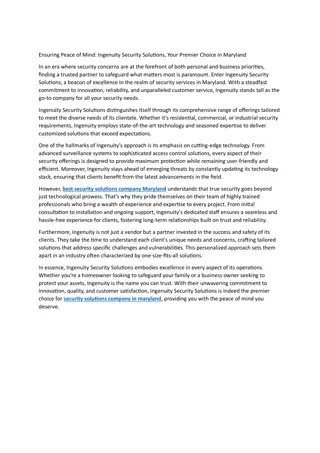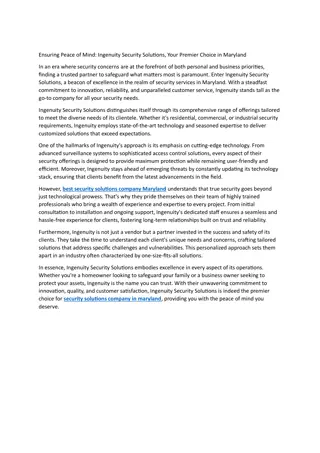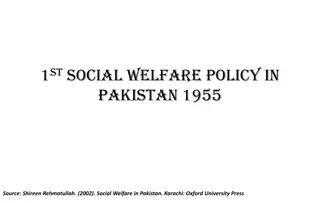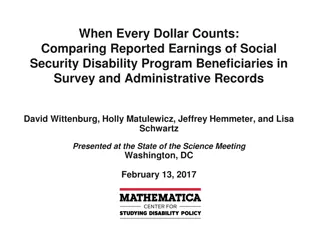Social Security Benefits and Policy Options Summary
Delve into Social Security benefits and policy options, exploring key aspects such as the number of beneficiaries, recipient demographics, payment amounts, and comparisons to earnings. Gain insights into the workings of Social Security and its impact on millions of Americans' lives.
Download Presentation

Please find below an Image/Link to download the presentation.
The content on the website is provided AS IS for your information and personal use only. It may not be sold, licensed, or shared on other websites without obtaining consent from the author.If you encounter any issues during the download, it is possible that the publisher has removed the file from their server.
You are allowed to download the files provided on this website for personal or commercial use, subject to the condition that they are used lawfully. All files are the property of their respective owners.
The content on the website is provided AS IS for your information and personal use only. It may not be sold, licensed, or shared on other websites without obtaining consent from the author.
E N D
Presentation Transcript
Social Security Benefits, Social Security Benefits, Finances, and Policy Options Finances, and Policy Options A Primer A Primer National Academy of Social Insurance www.nasi.org August 2016
What is What is Social Security? Social Security?
How Many People Receive Social Security? More than 60 million people receive Social Security each month, in one of three categories: Retirement insurance Survivors insurance Disability insurance Nearly 1 in 5 Americans gets Social Security benefits. About 1 in 4 families receives income from Social Security. Social Security Administration (SSA), 2016a; National Academy of Social Insurance, 2016. 3
Who Receives Social Security? 40.7 million retired workers 8.9 million disabled workers 4.2 million widows and widowers 2.5 million spouses 1.1 million adults disabled since childhood 3.2 million children SSA, 2016a. 4
How Much Does Social Security Pay? (June 2016) Average Monthly Average Monthly Benefit Benefit $1,348 Average Yearly Average Yearly Benefit Benefit $16,176 By Beneficiary Type: By Beneficiary Type: Retired workers $1,166 $13,992 Disabled workers $1,292 $15,504 Widows or widowers (60 or older) Average Monthly Average Monthly Benefit for Family Benefit for Family $2,233 Average Yearly Average Yearly Benefit for Family Benefit for Family $26,796 By Family Type: By Family Type: Retired worker and spouse (62 or older) Widowed mother or father (under 60) and two children Disabled worker and one or more children $2,639 $31,668 $1,793 $21,516 SSA, 2016a; SSA, 2016b; U.S. Department of Health and Human Services, 2016. 5
How Do Benefits Compare to Earnings? Replacement Rates for Retired Worker Age 65, 2016 Replacement Rates for Retired Worker Age 65, 2016 $140,000 Career-Average Wages $116,123 $120,000 $100,000 Benefits $76,369 $80,000 $60,000 $47,731 $40,000 26% 26% 32% 32% 39% 39% $21,479 53% 53% $20,000 $29,897 $24,628 $18,579 $11,270 $0 "Low" "Medium" Earnings Level Earnings Level "High" "Maximum taxable" Source: Social Security Administration. 2016. Replacement Rates For Hypothetical Retired Workers. Actuarial Note #2016.9. Baltimore, MD: Social Security Administration, Office of the Chief Actuary. 6
How Many Seniors Rely on Social Security for Most of Their Income? 84% of all people 65 and older get Social Security. Over 3 in 5 (61%) beneficiaries of Social Security get half or more of their income from Social Security. About 1 in 3 (33%) beneficiaries of Social Security get almost all (90% or more) of their income from Social Security. SSA, 2016e: Tables 2.A1 and 9.A1. 7
Reliance on Social Security By Race Percent of beneficiary households 65 or older Percent of beneficiary households 65 or older whose Social Security benefits make up: whose Social Security benefits make up: Half or more Half or more of their income of their income 60% 69% 62% 73% 90% or more 90% or more of their income of their income 32% 45% 41% 52% Race: Race: White Black Asian Hispanic 8 SSA, 2016e: Table 9.A3.
Reliance on Social Security By Gender and Family Type Percent of persons in beneficiary families 65 or Percent of persons in beneficiary families 65 or older whose Social Security benefits make up: older whose Social Security benefits make up: Half or more Half or more of their income of their income 61% 56% 90% or more 90% or more of their income of their income 34% 29% By Gender: By Gender: Unmarried women Unmarried men Percent of beneficiary households 65 or older Percent of beneficiary households 65 or older whose Social Security benefits make up: whose Social Security benefits make up: 48% 71% By Family Type: By Family Type: Married couples Unmarried people 21% 43% 9 SSA, 2016e: Tables 9.A2 and 9.B3.
Increase in Full Retirement Age (FRA) Lowers Retirement Benefits at Any Age Claimed 140 Full Retirement Age 65 Percent of Full Benefit Payable Percent of Full Benefit Payable 120 Full Retirement Age 67 100 80 60 40 20 0 62 63 64 65 66 67 68 69 70 Age When Benefits are Claimed Age When Benefits are Claimed Gregory et al., 2010. 10
Net Social Security Replacement Rates Will Fall Medium Earner s Replacement Rate at 65 (after Medicare Parts B & D premiums and taxation of benefits) 45 38% 38% 40 Percent of Prior Earnings Percent of Prior Earnings 34% 34% 35 31% 31% 30 25 20 15 10 5 0 2030 2030 2020 2020 2010 2010 Munnell, 2013. 11
What is Social Security Disability Insurance? Disability Insurance (DI) pays monthly benefits to 8.9 million workers who are no longer able to work due to illness or impairment. It is part of the Social Security program. Benefits are based on the disabled worker's past earnings. To be eligible, a disabled worker must have worked in jobs covered by Social Security. 12
What are the Most Common Disabilities for DI Recipients? Mental Impairments Musculoskeletal Conditions 20.2% 20.2% 31% 31% Circulatory System 9.3% 9.3% 8.3% 8.3% Nervous System/ Sense Organ Impairments 31.2% 31.2% Injuries/ Cancers/ Other Conditions SSA, 2015: Table 21. 13
Attributes of Disabled- Worker Beneficiaries 3 in 10 disabled workers have incomes below 125% of the poverty threshold. Disabled worker beneficiaries are more likely than other adults to be: Older (70% are over 50). African-American. Lower educational attainment: over half have only a high school diploma or less; almost 12% did not finish high school. Bailey and Hemmeter, 2015; SSA, 2015 14
Who Pays for Social Security? Workers and their employers pay with Social Security contributions under the Federal Insurance Contributions Act (FICA). 15
How Much Do Workers and Employers Pay? Workers contribute 6.2% of their earnings for Social Security. Employers match these worker contributions (6.2%). The total Social Security contribution is 12.4%. Earnings above $118,500 are exempt from Social Security contributions. National Academy of Social Insurance, 2016; SSA, 2016f 16
Where Does the Money Go? It is credited to the Social Security trust funds. Of the 6.2% tax rate: 5.015% goes to the retirement and survivor retirement and survivor insurance fund insurance fund 1.185% goes to the disability insurance fund disability insurance fund Projections of income and outgo of the trust funds are made by the Social Security Administration actuaries. Board of Trustees, 2016. 17
The Financial The Financial Outlook Outlook
2015 Finances Trust fund income = Trust fund outgo = Surplus = $920.2 billion $897.1 billion $23 billion $23 billion By law, surpluses are invested in U.S. Treasury securities and earn interest that goes to the trust funds. SSA, 2016d; Board of Trustees, 2016. 19
Where is Social Security Income From? Shares of Income to the Trust Funds, 2015 3.4% 3.4% 10.1% 10.1% 86.4% 86.4% Workers' and employers' Social Security contributions Interest on reserves Income taxes on benefits SSA, 2016d. 20
What are Social Security Reserves, or Assets? Social Security income that is not used immediately to pay benefits and costs is invested in special-issue Treasury securities (or bonds). The bonds earn interest that is credited to the trust funds. The accumulated surpluses held in Treasury securities are called Social Security reserves, or trust fund assets. The Treasury securities are secure investments that are backed by the full faith and credit of the United States government. 21
Disability Insurance Projections By law, Social Security has two separate trust funds: Disability Insurance (DI) Disability Insurance (DI) trust fund Old Old- -Age and Survivors Insurance (OASI) Age and Survivors Insurance (OASI) trust fund With the Bipartisan Budget Act of 2015, Congress temporarily rebalanced the distribution of Social Security payroll contributions between OASI and DI, extending solvency of the DI trust fund through 2022. In the 2016 Social Security Trustees Report, the DI trust fund s projected solvency was extended to late 2023. Reno, Walker, and Bethell, 2013. 22
How Large are Social Security Trust Fund Assets? 3.5 2019: $2.9 trillion (projected) 2015: $2.8 trillion 3.0 Trillions of Dollars Trillions of Dollars 2.5 2.0 1.5 1.0 1985: $0.04 trillion 0.5 0.0 1985 1990 1995 2000 2005 2010 2015 2020 Board of Trustees, 2016: Table VI.G8. 23
Social Security Income and Outgo $1,200 Amount (in billons of current dollars) Amount (in billons of current dollars) $1,000 Total income $800 $600 Outgo $400 $200 $0 2015 2016 2017 Board of Trustees, 2016: Table VI.G8. 24
How Do Actuaries Estimate the Future? Review the past: birth rates, death rates, immigration, employment, wages, inflation, productivity, interest rates. Make assumptions for the next 75 years (longer than the rest of the government). Three scenarios: Low cost; High cost; Intermediate (best estimate). 1) 2) 3) Board of Trustees, 2016. 25
The Long-Range Projection (Best Estimate) In 2020, revenues plus interest income to the trust funds are projected to be less than total expenditures for that year. Reserves will start to be drawn down to pay benefits. In 2034, trust fund reserves are projected to be depleted. Income is projected to cover 79% of benefits due then. By 2090, assuming no change in taxes, benefits or assumptions, revenue would cover about 74% of benefits due in that year. Board of Trustees, 2016. 26
Other Scenarios Low Cost: Low Cost: Social Security would be solvent for 75 years and beyond. High Cost: High Cost: Trust fund reserves would be depleted in 2029, instead of 2034. Board of Trustees, 2016. 27
The Actuarial Deficit (Best Estimate) The long The long- -range deficit is projected to be 2.66% of range deficit is projected to be 2.66% of taxable payroll. taxable payroll. This means: This means: The gap would be closed if the Social Security contribution rate were raised from 6.2% to 7.6% for workers and employers each. Board of Trustees, 2016. 28
Why Will Social Security Cost More in the Future? The number of Americans over age 65 will grow because: Boomers are reaching age 65 Boomers are reaching age 65 People are living longer after age 65 People are living longer after age 65 Birth rates are projected to remain at replacement levels. People 65 and older will increase from 15% to 23% of all Americans by 2090. Board of Trustees, 2016: Tables V.A1 and V.A3. 29
Percent of the Population Receiving Social Security and Percent Age 65+, 2010-2090 50% 40% Percent of the Population Percent of the Population 30% 25% 25% 24% 24% Beneficiaries Beneficiaries 18% 18% 20% 20% 20% Age 65+ Age 65+ 23 23% 15% 15% 10% 0% Board of Trustees, 2016: Tables V.A3 and IV.B3. 30
Can We Afford Can We Afford Social Security Social Security in the Future? in the Future?
Social Security in the Broader Economy Social Security Outgo as a Percent of the Economy (GDP), 2015-2090 50% 45% 40% 35% Share of GDP 30% 25% 20% 15% 10% 2090: 6.1% 2035: 6.0% 2015: 5.0% 5% 0% 2015 2025 2035 2045 2055 2065 2075 2085 Board of Trustees, 2016: Table VI.G4. 32
Taxable Payroll and Social Security Outgo as a Percent of the Economy (GDP) 2015-2090 50 45 40 2015: 35% 2015: 35% 2035: 37% 2035: 37% 2090: 34% 2090: 34% 35 Share of GDP Share of GDP 30 Taxable payroll as % of GDP 25 Social Security outgo as % of GDP 20 15 10 2035: 6% 2035: 6% 2090: 6% 2090: 6% 2015: 5% 2015: 5% 5 0 2015 2025 2035 2045 2055 2065 2075 2085 Board of Trustees, 2016: Tables VI.G4 and VI.G5. 33
Strengthening Strengthening Social Security Social Security
Options to Improve Adequacy Options that would improve the adequacy of benefits include: 1) Updating the special minimum benefit to ensure that long-serving, low-paid workers can remain out of poverty when they retire. 2) Reinstating student benefits until age 22 for children of disabled or deceased workers (currently, benefits for these children stop at age 18-19). 3) Allowing up to 5 childcare years to count toward benefits. 4) Increasing benefits for widowed spouses in low-earning couples. 5) Modestly increasing benefits for all by changing the benefit formula (to increase the first PIA bend point by 15 percent) 35
Options for Raising Revenues Options that would help raise revenues include: 1) Lifting or eliminating the cap (now $118,500) on the earnings on which workers and their employers pay Social Security contributions. 2) Gradually increasing the Social Security contribution rate from its current level of 6.2%. 3) Subjecting income from investments to Social Security contributions. 4) Treating all salary reduction plans like 401(k)s (subjecting income paid into them to Social Security contributions). 5) Restoring estate tax to 2000 level and dedicating to Social Security. 36
Other Options for Solvency Some proposals would reduce benefits for some or all beneficiaries in order to extend solvency. For example, raising the retirement age amounts to an across-the-board cut in benefits, and hence reduces the program s cost. Switching to the chained CPI as the basis for Social Security s cost-of-living adjustments (COLAs) would reduce benefits and hence program cost as well. Reno and Lavery, 2009. 37
Public Opinion Public Opinion on Social Security on Social Security
Consistent Findings throughout the Study In 2014, the Academy conducted a multigenerational study to understand Americans perspectives on Social Security. In focus groups, Americans expressed concern about benefits being too low. 77% 77% said it is critical to preserve Social Security benefits, even if it means raising taxes on working Americans. Walker, Reno, and Bethell, 2014. 39
Consistent Findings throughout the Study In the trade-off analysis, the package preferred by 71% of respondents respondents would: 71% of Gradually increase taxes increase taxes in two ways: for high earners by eliminating the taxable earnings cap; For all workers by raising the tax rate by 1/20 of 1% per year. Increase benefits Increase benefits in two ways: For low earners by increasing the special minimum benefit; For all beneficiaries by basing COLAs on the inflation experienced by the elderly. Walker, Reno, and Bethell, 2014. 40
Majorities of Republicans, Democrats, and Independents Agree Percent agreeing: It is critical that we preserve Social Security for future generations, even if it means ... increasing the Social Security taxes paid by working Americans increasing the Social Security taxes paid by wealthier Americans 100% 92% 92% 90% 84% 84% 84% 84% 83% 83% 77% Percent Agreeing Percent Agreeing 76% 76% 80% 71% 71% 69% 69% 70% 60% 50% 40% 30% 20% 10% 0% Total Republican Democrat Independent Walker, Reno, and Bethell, 2014.
Demographic Support for Package of Policy Options Preferred by 71% of Americans Walker, Reno, and Bethell, 2014. 42
Recap Benefits are modest (dollars and replacement rates). Yet they are most beneficiaries main source of income. most beneficiaries main source of income. Social Security benefits will replace a smaller share of earnings in the future than they do today (replacement rates are declining (replacement rates are declining because of the increase in the retirement age) because of the increase in the retirement age). Revenue increases or benefit cuts will be needed Revenue increases or benefit cuts will be needed to balance Social Security s future finances. Lawmakers have many options have many options to raise revenues, lower future benefits, or increase benefits to improve adequacy. Americans value Social Security Americans value Social Security and are willing to pay for it. Americans report they would rather pay more Americans report they would rather pay more than see future benefits reduced. 43
References Board of Trustees. 2016. Annual Report of the Board of Trustees of the Federal Old-Age and Survivors Insurance and Federal Disability Insurance Trust Funds. Washington, DC: Social Security Administration. Bailey, Michelle Stegman and Jeffrey Hemmeter. 2015. Characteristics of Noninstitutionalized DI and SSI Program Participants, 2013 Update. Research and Statistics Note No. 2015-02. Washington, DC: Social Security Administration. http://www.ssa.gov/policy/docs/rsnotes/rsn2015-02.html Gregory, Janice M., Thomas N. Bethell, Virginia P. Reno, and Benjamin W. Veghte. 2010. Strengthening Social Security for the Long Run. Social Security Brief No. 35. Washington, DC: National Academy of Social Insurance. Munnell, Alicia H. 2013. Social Security s RealRetirement Age is 70. Brief No. 13-15. Chesnut Hill, MA: Center for Retirement Research at Boston College. National Academy of Social Insurance. 2016. Social Security Finances: Findings of the 2016 Trustees Report. Social Security Brief No. 46. Washington, DC: National Academy of Social Insurance. Reno, Virginia P. and Joni Lavery. 2009. Fixing Social Security: Adequate Benefits, Adequate Financing. Washington, DC: National Academy of Social Insurance. Reno, Virginia P., Elisa A. Walker, and Thomas N. Bethell. 2013. Social Security Disability Insurance: Action Needed to Address Finances. Social Security Brief No. 41. Washington, DC: National Academy of Social Insurance. Social Security Administration. 2016a. Beneficiary Data: Number of Social Security Recipients at the end of June 2016. Baltimore, MD: Social Security Administration, Office of the Chief Actuary. www.ssa.gov/cgi-bin/currentpay.cgi
References (cont.) Social Security Administration. 2016b. Beneficiary Data: Benefits Paid by Type of Family. Baltimore, MD: Social Security Administration, Office of the Chief Actuary. www.ssa.gov/OACT/ProgData/famben.html Social Security Administration. 2016c. Replacement Rates For Hypothetical Retired Workers. Actuarial Note #2016.9. Baltimore, MD: Social Security Administration, Office of the Chief Actuary. https://www.ssa.gov/oact/NOTES/ran9/an2016-9.pdf Social Security Administration. 2016d. Trust Fund Data. Baltimore, MD: Social Security Administration, Office of the Chief Actuary. http://www.socialsecurity.gov/OACT/ProgData/allOps.html Social Security Administration. 2016e. Income of the Population 55 or Older, 2014. Washington, DC: Social Security Administration, Office of Research, Evaluation, and Statistics. Social Security Administration. 2016f. Annual Statistical Supplement to the Social Security Bulletin, 2015. Washington, DC: Social Security Administration, Office of Research, Evaluation, and Statistics. Social Security Administration. 2015. Annual Statistical Report on the Social Security Disability Insurance Program, 2014. Washington, DC: Social Security Administration, Office of Research, Evaluation, and Statistics. Social Security Administration. 2013. Further breakdown of table 9.A1. Unpublished data, received March 12, 2013. Washington, DC: Social Security Administration, Office of Research, Evaluation, and Statistics. Walker, Elisa A., Virginia P. Reno, and Thomas N. Bethell. 2014. Americans Make Hard Choices on Social Security: A Survey with Trade-Off Analysis. Washington, DC: National Academy of Social Insurance. U.S. Department of Health and Human Services. 2016. 2016 Poverty Guidelines. Washington, DC: Department of Health and Human Services. https://aspe.hhs.gov/poverty-guidelines























